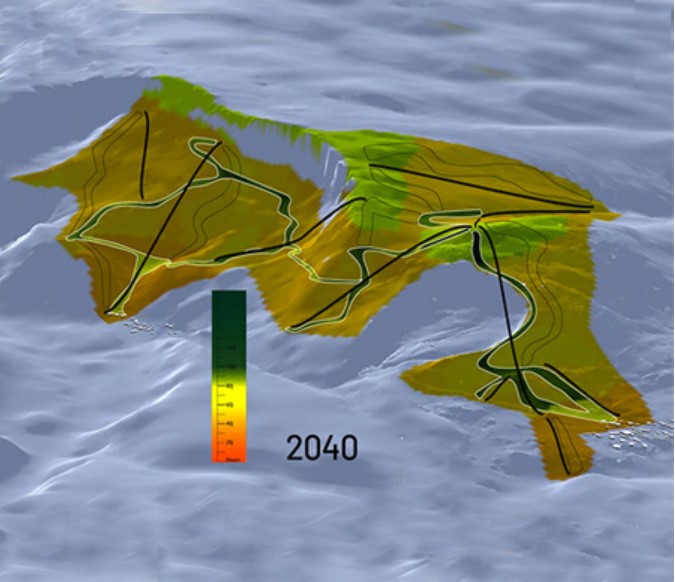ClimSnow, a novel climate service to inform ski resorts strategies in France

Summary
ClimSnow is a climate service developed to inform ski resorts’ strategies in the context of climate change. It provides estimates of the snow reliability within ski resorts across several mountain regions in France. ClimSnow is a novel climate service addressing the long term impact of climate change on snow reliability in ski resorts, primarily in France, developed to inform ski resorts strategies in the context of climate change. It is based on a series of modeling tools developed at Météo-France-CNRS and INRAE in the past years, providing estimates of the snow reliability within ski resorts, explicitly taking into account snow management (grooming and snowmaking), and using ensembles of climate change scenarios adjusted to the mountain regions in France. Initially applied to the ski resorts of the Isère department, Northern French Alps as a prototype and first application, it is now developing across several French mountain regions.
The service is operated by the Dianeige consulting company, with scientific support from Météo-France and INRAE. This enables scaling up the provision of this service to a growing number of ski resorts, in an operational and commercial context, and including a consulting component benefitting from long standing expertise of Dianeige in providing consultancy services to mountain resorts, complementing the scientific figures on past and future climate change impacts on snow reliability.
ClimSnow takes into account the detailed configurations of ski resorts (ski lifts, ski pistes, snowmaking units) thanks to in-depth exchanges with ski resorts, making it possible to provide concrete analyses and recommendations in terms of adaptation strategies, such as targeted enhancements of snow reliability taking into account future climate impacts and risks, and diversification of tourism activities across all seasons. The presentation will provide a synthesis of the underpinning scientific and technical elements to ClimSnow, and provide a status report on current operations and potential for development.
Overview
- Implementation sites:
-
- Multiple countries
- Multiple locations
- Mountain region:
-
French Alps, Pyrenees, Jura
- Province:
-
- Auvergne-Rhône Alpes, Sud, Occitanie, Bourgogne-Franche Comté
- Site locations:
-
Multiple locations in the mountain ranges highlighted above
- Solution scale:
- Ecosystem type(s):
- Solution type(s):
- Sector(s):
- Other climate impact(s) addressed:
-
- Natural snow scarcity (frequency of “bad winters”); Increasing temperature (impacts on precipitation type snowfall vs. rainfall and on snow production capabilities)
- Climate impact time-scale(s):
- Main benefit associated with the solution:
- Other co-benefits(s) associated with the solution implementation:
-
- ClimSnow illustrates the consequences of climate change and thus makes a strong case for the benefits of reduced GHG emissions
- Implementation timeline:
-
- 2019
- Sendai targets:
-
Solution details
Main beneficiaries & outcomes
Mostly ski resorts managers and staff members, but also all relevant stakeholders (mayors and other elected representatives, municipal and local authorities, reglementary authorities such as environmental protection authorities, investors, general population willing to engage into deliberations about the future of mountain area under a changing climate, environmental protection organizations such as NGOs).
ClimSnow contributes to climate risk reduction through a better anticipation (at the scale of several decades) of long term changes in natural and managed snow cover reliability, and implementation of policy decisions to cope with the changing operating conditions of ski resorts. Policy decisions made on the basis of ClimSnow range from local support to further snowmaking, in order to maintain “adequate” snow conditions for a given time span into the future, to strong support to diversification of activities (both options can coexist depending on local settings).
ClimSnow enables ski resorts and related parties (municipal authorities, socio-economic stakeholders etc.) to appreciate the extent of the impact of climate change on the operating conditions of ski resorts and promote meaningful deliberations in support to the various options for coping with and adapting to a changing climate.
Beyond the capability for ClimSnow to enable reaching informed decisions in ski resorts in terms of climate change adaptation, ClimSnow also serves the purpose of illustrating the consequences of climate change and as such makes a strong case for the benefits of reducing GHG emissions, in order to avoid further changes beyond the state reached by the mid 21st century.
Planning and implementation
ClimSnow results from over 10 years of research in the field of climate change impacts to ski tourism activities. For more information, see the publications in the Resources section.
Finance
The solution has mostly been financed by public funding from the main organizations which carried out research on the topic (Météo-France and INRAE). Self funding has not been quantified but is of the order of 500 k€ to 1 M€ over the period from 2012 to 2020, taking into account salary of permanent staff involved and computing/storing resources. Further funding was obtained from grants provided by the Région Rhône ALpes (PhD studentship of Pierre Spandre 2013-2016, about 100 k€), the French Ministry of Environment (GICC project ADAMONT 2014-2018, about 130 k€), the INTERREG POCTEFA (Clim’Py project 2015-2019, about 200 k€), and funding from Département de l’Isère for the pilot/prototype phase (2017-2018, about 70 k€). Altogether, the solution was developed with a total use of resources of the order to 1 to 2 M€ over the time period from 2012 to 2020.
Innovation
Combination of state of the art climate change information (downscaling of regional climate models) driving dedicated impact models (snow cover model accounting for snow management) and a dedicated representation of ski resorts characteristics (slope, etc.) in order to provide a dedicated assessment of the impact of climate change on this sector. The innovation lies also in the development of dedicated indicators (focusing on how often challenging snow conditions are encountered under current and future climate conditions) and co-design of the service with pilot ski resorts and local authorities.
Performance evaluation
The performance of ClimSnow has not been evaluated specifically, it is currently in a growing phase with about 100 ski resorts under investigation and growing.
Long term project sustainability and maintenance
ClimSnow is jointly operated by Dianeige, Météo-France and INRAE, which invest resources in maintaining all required resources for running the service and regularly update its underpinning elements as the science develops and further innovations can be implemented – including in the design of material provided to the users.
Capacities for design and implementation
Knowledge
Research was instrumental in developing ClimSnow. This research was partly based on assessing local knowledge about snow management to develop appropriate climate change impact models. The solution itself uses local information and knowledge to provide relevant information at the local scale.
Technology
GIS is critical for bringing together all the information used in ClimSnow services. Climate modelling and snow cover modelling are also a crucial component of CLimSnow.
Political / Legal
The ClimSnow solution benefitted from support from local authorities, willing to assess the climate change impacts to ski tourism in order to better support their policy decisions, in particular the balance between further funding snowmaking capacity vs. focusing on tourism diversification. This was particularly the case of the Isère Département (pilot study). The ClimSnow service is of no use if it is not commissioned/endorsed by authorities ready to make use of the outcome of the study in their deliberations and operations.
Institutional
Implementing ClimSnow requires strong political and administrative support. The solution has been promoted through various forums and gained increased acceptance by ski tourism representative bodies in France.
ClimSnow is explicitly mentioned and supported in the French “Avenir Montagnes” program announced in May 2021, as a means to promote and develop a more diverse and more resilient tourism sector in French mountainous regions
https://www.gouvernement.fr/avenir-montagnes-5-mdeu-pour-soutenir-les-acteurs-de-la-montagne
Socio-cultural
As indicated above, ClimSnow makes it possible for people and organizations, including NGOs, with very different views on tourism development, to deliberate and engage in meaningful conversations. In a way, ClimSnow has been an enabling factor for the current discussions about the transition of mountain tourism in France, announced on the EUSALP event on climate change and ski resorts organized in Metabief, France, on March 16 and 17, 2021, where ClimSnow was introduced in the opening ministerial plenary.
Outlook & Scalability
Barriers and adverse effects
Not so many barriers were encountered, except the fact that it took almost 10 years to develop the solution and that many sources of funding needed to be combined in order to achieve the results. The solution has no known side effects.
Transformation and future outlook
As indicated above, ClimSnow makes it possible for people and organizations, including NGOs, with very different views on tourism development, to deliberate and engage in meaningful conversations. In a way ClimSnow has been an enabling factor for the current discussions about the transition of mountain tourism in France, announced on the EUSALP event on climate change and ski resorts organized in Metabief, France, on March 16 and 17, 2021, where ClimSnow was introduced in the opening ministerial plenary.
Potential for upscaling and replication
ClimSnow is currently not included in national adaptation plan but has been showcased to a number of governmental organizations in France and may be included in the portfolio of solutions advised to mountain resorts within the framework of post-Covid / climate transition funding/investment schemes (eg French “Avenir Montagnes” programme) ClimSnow is already attracting requests for implementation in other countries. ClimSnow is explicitly mentioned and supported in the French “Avenir Montagnes” program announced in May 2021, as a means to promote and develop a more diverse and more resilient tourism sector in French mountainous regions:
https://www.gouvernement.fr/avenir-montagnes-5-mdeu-pour-soutenir-les-acteurs-de-la-montagne
Although the resolution and features of the underlying data are not similar, it is possible that ClimSnow will expand, with adaptations, to the European scale based on the Copernicus Climate Change Service “Mountain tourism meteorological and snow indicators for Europe from 1950 to 2100 derived from reanalysis and climate projections” (corresponding application here). The development and implementation principles of ClimSnow are also seen as an inspiration for addressing other sectoral needs, not necessarily in the field of mountain and/or tourism.
- ClimSnow Project Website
- Snow reliability and water availability for snowmaking in the ski resorts of the Isère département (French Alps)
- Climate controls on snow reliability in French Alps ski resorts
- Winter tourism under climate change in the Pyrenees and the French Alps
- Panel based assessment of snow management operations in French ski resorts
- Integration of snow management processes into a detailed snowpack model
- Crossing numerical simulations of snow conditions with a spatially-resolved socio-economic database of ski resorts



Comments
There is no content